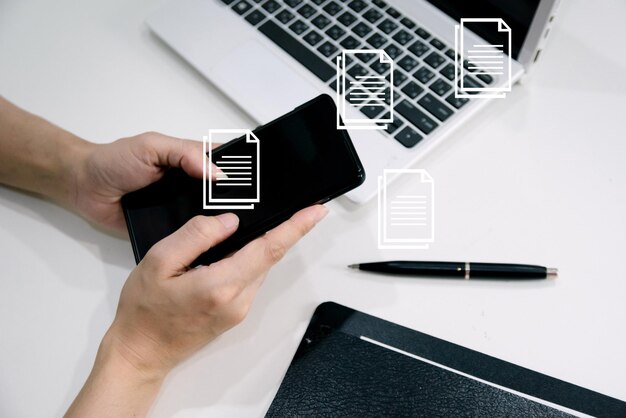Effortlessly Transfer Data from Android to iPhone After Setup: Your Ultimate Guide
Switching from Android to iPhone can be an exciting journey. Whether you're moving because you love Apple's ecosystem or are curious about its features, there's one big hurdle to overcome: transferring your data after setting up your iPhone. While initial setup data migration is straightforward, doing it after setup can seem daunting. Fear not! Here's your comprehensive guide to ensure a seamless transition.
Setting the Stage for Data Transfer
Buying a new iPhone is thrilling, but the task of migrating all your important information from your Android can feel like a logistical puzzle. It's crucial to approach this with a clear plan, understanding all available methods. In this section, we'll explore various techniques and tools pre-built in the Apple ecosystem to make this transfer a breeze.
Understanding the Basics of iOS and Android
Both Android and iOS are powerful operating systems but are inherently different in structure. Knowing how each handles data will streamline your transfer process. Android offers more flexibility and integration with Google's cloud services, whereas iOS is known for its security and integration with Apple's services.
The Role of Apps in the Transfer Process
Many apps facilitate data transfer, but Apple's own "Move to iOS" might have limitations after you've set up your iPhone. In this guide, we will discuss other methods such as using third-party cloud services or apps for transferring specific types of data like contacts, photos, and more.
Techniques to Transfer Data After iPhone Setup
1. Move to iOS: Revisited
While typically used during initial setup, you can restart the iPhone setup process if you missed using "Move to iOS." This involves erasing your iPhone, which isn't ideal for everyone. Consider this as a last resort if backup solutions aren't feasible.
2. Manual Transfer Using Google Account
For those primarily using Google's suite of services, you're in luck. Sync your contacts, emails, and calendars through Google:
- Contacts: Make sure your Android's contacts are synced to your Google account. On iPhone, navigate to Settings > Mail > Accounts, then add your Google account and ensure "Contacts" is enabled.
- Emails and Calendar: Similarly, enable syncing for email and calendar events.
3. Photos and Videos: Google Photos and Alternatives
Transferring your cherished memories can be straightforward:
- Google Photos: Upload your photos on Android and access them via the Google Photos app on iPhone. Simply log in, and you're good to go.
- Alternatives: Use services like Dropbox or OneDrive similarly, uploading on Android and accessing on iPhone.
4. Music: Google Play Music to Apple Music or Spotify
If you're an audiophile, transfer using:
- Apple Music: Manually import music to your iTunes and sync to your iPhone.
- Spotify: Use the app on both devices to access your playlists seamlessly, requiring no additional action.
5. Apps and App Data
While you can't directly transfer apps, many apps save data in the cloud. Re-download from the App Store, and upon logging in, many will restore your data automatically.
6. Using Third-party Applications
There are apps specifically designed for data transfer that support cross-platform migration. Research and choose one with positive reviews and transparent privacy policies.
Tips for a Smooth Transition
Switching devices doesn't have to be stressful. Here's a quick list of tips to streamline your migration:
- 🔍 Backup First: Always back up data on both devices to avoid accidental loss.
- 🌐 Strong Network: Use a stable and secure Wi-Fi connection for faster data transfer.
- ☁️ Cloud Services: Rely on cloud storage for photos, videos, and documents to simplify the process.
- 🔄 Synchronize: Regularly sync Google account settings on Android before initiating the transfer to your iPhone.
- 🛠️ Check App Compatibility: Some apps may not have iOS equivalents—plan alternatives in advance.
Pros and Cons of Different Transfer Methods
Manual Transfer
- Pros: High control over data selection, security.
- Cons: Time-consuming, technical know-how needed.
Using Google Services
- Pros: Highly convenient, seamless integration.
- Cons: Limited to Google-based data.
Third-party Apps
- Pros: All-in-one solution, streamlined process.
- Cons: Potential privacy risks, possible costs.
Erasing and Using Move to iOS
- Pros: Comprehensive transfer.
- Cons: Data loss from erasing, time involved.
Closing Insights: Embrace the Apple Ecosystem
Transitioning your digital life from one platform to another might seem monumental, but choosing the right strategy reduces friction significantly. Apple's ecosystem, known for its seamless device interoperability, will soon make your user experience intuitive and rewarding.
Take your time, choose the tools that best suit your data sets, and enjoy all the new features your iPhone offers. Your Android-to-iPhone journey marks the beginning of exploring one of the most advanced personal tech ecosystems available today.
So here's to new beginnings, new devices, and a world of possibilities right in your palm. 📱✨

Related Topics
- How Can I Transfer a Video From Iphone To Computer
- How Can I Transfer Apps From Iphone To Ipad
- How Can I Transfer Apps From One Iphone To Another
- How Can I Transfer Contacts From Iphone To Iphone
- How Can I Transfer Contacts From One Iphone To Another
- How Can I Transfer Data From Iphone To Android
- How Can I Transfer Data From Iphone To Iphone
- How Can I Transfer Data From Iphone To Samsung
- How Can I Transfer Files From Android To Pc
- How Can I Transfer From Iphone To Samsung